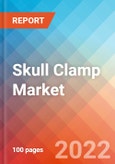The Skull Clamp market report provides an overview of Skull Clamp , applications of Skull Clamp as well as its advantages and limitations. Additionally, the report provides insight on the Skull Clamp market share by segments, along with assessment of market share by regions, the qualitative and quantitative (USD million, 2019-2027) data will be provided for all the segment in the scope. Moreover, the report also covers the market drivers, market challenges and restraints, and opportunities, along with the impact COVID-19 has had on this market. Assessment of Key 12-15 Players operating in the Skull Clamp market will be covered in-depth in the report comprising of company overview, financial overview, product overview and company share analysis of key 3-5 players. Additionally the PORTER's analysis will also be provided to give an analytical edge to the Skull Clamp market report.
Study Period: 2019-2027
Geography Covered
- North America
- The United States
- Canada
- Mexico
- Europe
- Germany
- France
- Italy
- Spain
- The United Kingdom
- Russia
- Rest of Europe
- Asia Pacific
- Japan
- China
- India
- South Korea
- Australia
- Rest of APAC
- RoW
- Middle East
- Africa
- South America
Skull Clamp - Competitive Analysis
This segment of the report provides a brief competitive analysis of Skull Clamp , to help understand the competition in the market. It gives a comparative understanding of the Key Companies in the market.
Skull Clamp : Market Analysis
This segment illustrates the global market of Skull Clamp along with the market segmentation. Furthermore, the Skull Clamp market report will provide the regional level cross-segmentation quantitative data. Moreover, the assessment is done on how the market is expected to rise in the study period (2019 to 2027), at a significant CAGR.
KOL-Views
To keep up with the market trends, we take KOLs and SME's opinion working in Skull Clamp domain through primary research to fill the data gaps and validate our secondary research. Their opinion helps to understand and validate current and emerging Skull Clamp market trend. This will support the clients in making informed business decisions by identifying the overall scenario of the market and the unmet needs.
Scope of the Report
- The report covers the descriptive overview of Skull Clamp , explaining its applications, advantages, and limitations, etc.
- Additionally, detailed profiles of the Key Companies operating in the market is provided, along with the market share of the Key 3-5 players.
- A detailed review of Skull Clamp market; historical and forecasted market size is included in the report, covering global outreach.
- The report provides an edge while developing business strategies, by understanding trends shaping and driving the global Skull Clamp market.
Report Highlights
- The report also reviews the detailed global historical and forecasted Skull Clamp market including assessing the outreach in America, Europe, APAC, and Rest of World (RoW).
- The report helps in developing business strategies by understanding trends shaping and driving the global Skull Clamp market.
- The impact of COVID-19 on the Skull Clamp market will be discussed in detail in the report.
Skull Clamp Report Key Strengths
- 5 Years Forecast
- Global Coverage
- Competitive Landscape
- Skull Clamp Market Size
- Skull Clamp Market Segmentation
- Skull Clamp Market Company Profiles
- Skull Clamp Market PORTER's Five Forces Analysis
- Skull Clamp Market Company Share Analysis (Key 3-4 players)
Skull Clamp Report Assessment
- Marketed Product profiles
- Key Products and Key Players
- Market Drivers and Barriers
- Market Forecast
- KOL'S views
Key Takeaways from the Skull Clamp Market Report Study
- Skull Clamp Market size analysis for current market (2020), and Skull Clamp market forecast for 5 years (2021-2027)
- The effect of the COVID-19 pandemic on Skull Clamp market is significant. To capture and analyze suitable indicators, our experts are closely watching the Skull Clamp market.
- Top key product/services/technology developments, merger, acquisition, partnership, joint venture happened for last 3 years in Skull Clamp market.
- Key companies dominating the Global Skull Clamp Market.
- Various opportunities available for the other competitor in the Skull Clamp Market space.
- What are the top performing segments in 2020? How these segments will perform in 2027.
- Which is the top-performing regions and countries in the current Skull Clamp market scenario?
- Which are the regions and countries where companies should have concentrated on opportunities for Skull Clamp market growth in the coming future?
Target Audience who can benefit from Skull Clamp Market Report Study
- Skull Clamp providers
- Research organizations and consulting companies
- Skull Clamp related organization, association, forum, and other alliances
- Government and corporate offices
- Start-up companies, venture capitalists, and private equity firms
- Distributors and Traders in Skull Clamp market
- Various End-users who want to know more about the Skull Clamp Market and latest technological developments in the Skull Clamp market.
This product will be delivered within 2 business days.








